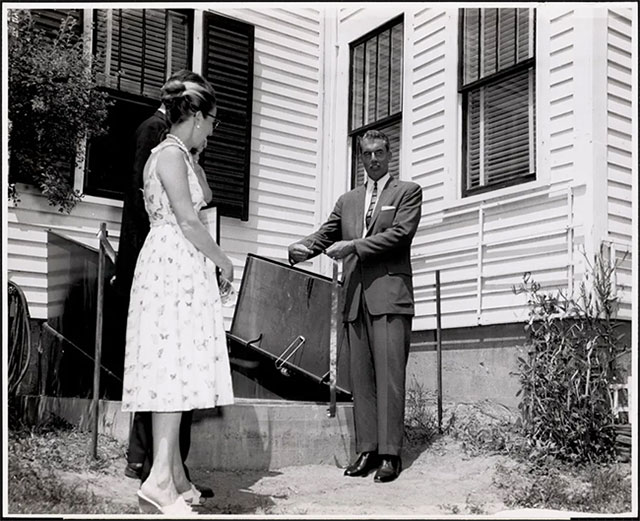History of nuclear disaster shelters
What is a nuclear bunker? What is its history, and how have they changed over time? Please see the article below for more details.
It all started in Japan in the 1940s, right after the two nuclear bombings at Hiroshima and Nagasaki, with images of hibakusha (Japanese bomb survivors) and cities left with only ashes. appear in newspapers. Since that time, Japanese pop culture has been obsessed with nuclear bombs, from genbaku bungaku (literature about nuclear disaster) to Godzilla (1954), to the global success of anime blockbusters. such as Akira (1988) and works by Studio Ghibli.
Each ethnic group has a different cultural response to bombs. In the United States, the Federal Civil Defense Commission (FCDA), established in 1951, set out on a mission to reassure Americans that if there were indeed a nuclear bomb dropped, they were quite likely to survive. . Over the course of a decade, the agency has gone to great lengths to assuage public anxiety over the possibility of a US-Russian nuclear strike through numerous public education campaigns and instructions on how to avoid school bombs. study, and many other activities.

Nuclear bunker.
The nearly half a billion notebooks that FCDA publishes describe American families hiding in bomb shelters, creating a typical image in the American mind at the beginning of a story about nuclear war. These middle-class white suburban families are often illustrated filling their bomb shelters with cans of industrial food, or holding children's hands as they walk down the tunnel, with a strong belief in their word. government promise: as long as the family is together, fully prepared, and ready to follow orders, it will be possible to survive the coming war. Of course, this message was primarily political, and was also a way for the US government at the time to promote traditional ideas about the value of marriage and family.
Moreover, the above-mentioned survival guidelines also indirectly push responsibility away from the state. Putting responsibility on the individual helps ease America's financial burden, and makes its nuclear war policy more appealing - but with the development of the hydrogen bomb and the discovery of a Nuclear bomb explosions can cause cancer and cardiovascular diseases, and by the 1960s, the first generation of Americans who had grown up under the specter of nuclear weapons had begun to doubt the so-called 'victory' if nuclear war broke out.
That's also when the anti-nuclear bomb movement took place, and with it, the image of families leading each other into nuclear bunkers, famous in popular culture, became illusory. In the 1961 episode of The Twilight Zone, a quiet dinner party turns into a terrifying brawl as suburban residents jostle for the entrance to the town's only bunker. Before the Cuban Missile Crisis, the Saturday Review recorded a meeting at the Hartford, Connecticut city hall, which was turned into chaos by a member of the public threatening to shoot anyone who approached the bunker. his own.
The image of nuclear shelters continues to change, reflecting people's attitudes towards the upheavals of the Cold War period. When Vietnam became the name mentioned with dense frequency in the newspapers in the late 1960s and 1970s, people almost stopped talking about home nuclear shelters. But a generation later, when Ronald Reagan was elected President of the United States, the specter of nuclear war once again appeared.

The image of nuclear bunkers continues to change over time.
Nuclear bunkers have re-emerged – though images of 1950s families living happily underground have become a relic of the distant past. In the 1980s, as the global number of nuclear warheads reached more than 50,000, the visual culture surrounding bunkers also grew bleak. With anti-nuclear movement on the rise, bunkers look like the last hopeless ramparts in a world where hope is a luxury.
In Britain, where NATO stockpiled cruise missiles in 1979, filmmakers have produced two remarkable productions about families living in bunkers awaiting the end of the world. The animated film When the Wind Blows (1986) tells the story of an elderly couple, Jim and Hilda Bloggs, who live in the Cotsworlds village after a nuclear attack leaves Britain in a radioactive wasteland. Before that was the documentary Threads (1984) about the horrors of thermonuclear war in Sheffil and plunged an entire generation into psychological trauma.
The end of the Cold War also turned the nuclear bunker into a historical relic, and then the center of nostalgia, as demonstrated in films like Blast From the Past (1999), 'I Love Lucy', 'The Honeymooners', or the game title 'Fullout' (1997).
Recent events have brought the image of nuclear shelters back. It is difficult to predict what will happen next. One thing is for sure, the image of those bunkers still has the ability to startle us with apprehension. Will that encourage today's generation to join hands to create a new world where nuclear bunkers are once again harmless?
- Boxed intelligent shelter
- Inside the nuclear bomb shelter in Japan
- Photos of 30 years of disaster Chernobyl nuclear power plant
- What can be eaten after a nuclear war disaster?
- VN nuclear power before Japanese nuclear disaster
- Lessons from Japanese nuclear disaster
- Seeing strange manholes in the yard, crawling down to discover the majestic secret
- How to survive the nuclear disaster
- Ukraine celebrates the 25th anniversary of the Chernobyl disaster
- Looking back on 2 years of Fukushima nuclear disaster
- A wake-up call from 'artificial disaster' Fukushima
- Nuclear disaster can happen at any time
 The most famous scientific failures in history
The most famous scientific failures in history Mysterious genius mechanic and the machine froze time
Mysterious genius mechanic and the machine froze time The son carries the 'bad gene' of genius Albert Einstein
The son carries the 'bad gene' of genius Albert Einstein Isaac Newton
Isaac Newton